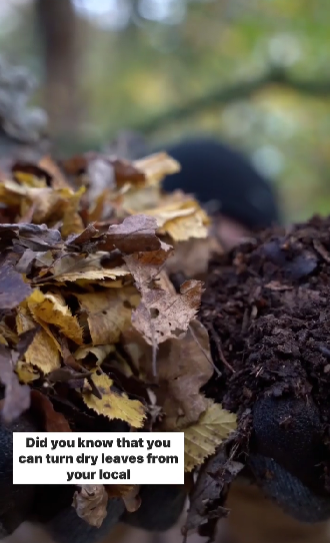Did you know that you can turn dry leaves from your local woods into one of the best soil amendments for your garden? I took a walk in the local woods in London and collected leaves on the ground. It’s a waste for others, but for us gardeners, it’s a hidden gem.
Leaf mold is no more than the layer of fallen forest leaves decomposed by fungi over time. The best part? This organic, all-natural soil conditioner is readily available, teeming with beneficial microorganisms, and absolutely free!
So if you are looking for a free soil amendment that is jam-packed with microorganisms and easy to find, leaf mold is exactly what you need!

Garden Benefits in Abundance
- Integrating leaf mold into your garden unlocks a treasure trove of advantages.
- Enhances soil structure: Makes it lighter and more aerated, fostering healthy root growth.
- Retains moisture: Helps soil retain moisture, reducing the need for frequent watering.
- Acts as a slow-release fertilizer: Provides a consistent supply of nutrients for steady, robust plant growth.
- Suppresses weeds: Forms an organic mulch that blocks sunlight from reaching weed seeds, disrupting their germination process.
- Low-maintenance: Saves time and effort on weeding, leading to a more beautiful garden with less work.
Rustling up Your Own Leaf Mold
- Prepare for Collection:
- Choose an area free from chemicals and pesticides.
- Check with your local council for any regulations regarding the collection of leaf mold.
- Look out for diseased plants in the area and avoid collecting leaves from these plants.
- Unearthing Leaf Mold:
- Venture out into your chosen area.
- Brush aside the first layer of dry leaves to reveal the dark brown, earthy-textured substrate below.
- Collect the leaf mold using a rake or your hands.
- Using Leaf Mold:
- Use the collected leaf mold as mulch to protect and nourish your garden plants.
- Incorporate it into a seed soil mix to improve soil structure and provide nutrients.
- Use it as a base for homemade potting soil to enhance plant growth.
- Creating Your Own Leaf Mold:
- Collect dry leaves from your local park or garden.
- Pack the leaves into a bin bag, and poke some holes in the bag for aeration.
- Leave the bag in a cool, damp area and let nature decompose the leaves over time.
- In a few years, you’ll have your own batch of earthy-textured leaf mold ready for use.
- Additional Tips:
- Turn the leaf pile occasionally to aid decomposition.
- Keep the pile moist but not soggy, to encourage decomposition
- Use a mix of different types of leaves for a nutrient-rich leaf mold.
A few recommendations before choosing the area. Make sure it has not been sprayed by any chemicals, check with your council for any regulations on collecting leaf mold; and be careful for diseased plants around the area.

In a world where the best things in life are free, leaf mold proves this saying. So, the next time you see a pile of fallen leaves, remember that they are not only a reminder of the changing seasons, but also an excellent opportunity to naturally improve the health and vitality of your garden!
Happy growing!

